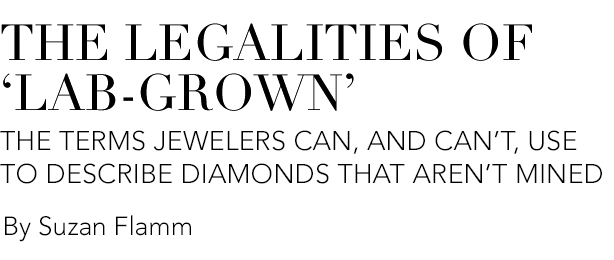


Suzan R. Flamm is senior counsel of the Jewelers Vigilance Committee, which provides general educational resources and jeweler-specific advice. The advice is strictly the opinion of the JVC. Flamm can be reached at suzan@jvclegal.org.
Manufactured diamonds are widely available to consumers, both online and in large brick-and-mortar retail stores.
To non-experts, these products can be indistinguishable from natural diamonds. It takes skill, and the right equipment, to determine whether a stone was produced by nature or by man. This is a remarkable technological achievement, but it makes the sale of manufactured diamonds vulnerable to misunderstandings.
Here’s a reminder of how to avoid confusion and deception when marketing and describing any product that looks like a diamond but is not a naturally mined mineral.
Background: The Federal Trade Commission’s Jewelry Guides
The Federal Trade Commission (FTC) is the federal agency tasked with preventing fraud and deception in the marketplace. To help the jewelry trade understand what it considers unfair and deceptive, the FTC issued the Guides for the Jewelry, Precious Metals and Pewter Industries in 1996.
The standards set forth in the Guides apply to sellers at every level of the trade, including manufacturers, suppliers and retailers. Among many other subjects, such as precious metals, pearls and colored gemstones, the Guides address diamonds.
According to the Guides, the term “diamond,” without qualification, may only be used to describe a natural mineral. When describing other products that look like diamonds, but are not natural minerals, the term “diamond” may be used, but must be qualified to avoid confusion and deception, such as “laboratory-grown diamond” or “simulated diamond.” As discussed below, the exact qualifier to use depends on whether the product is a lab-grown diamond or an imitation. The differences are explained below.
Natural, Synthetic and Simulated Diamonds: The Differences
A lab-grown diamond is made by man from pure carbon, the same chemical substance that turns into diamond when exposed by nature to extremely high pressure. While the natural process occurs deep within the earth’s lithospheric mantle, the manufacturing process takes place above ground in a manufacturing facility. Despite the difference in production location, lab-grown diamonds have essentially the same optical, physical and chemical properties as a natural diamond. They are pure carbon crystallized in an isometric system.
An imitation diamond, on the other hand, does not share the same optical, physical and chemical properties as a natural diamond. It is a manufactured simulant that can closely resemble a diamond, but is not made of carbon. Imitations are typically made of glass, plastic or cubic zirconium. CZ is the cubic crystalline form of zirconium dioxide, a material that is hard, optically clear and usually colorless.
The untrained eye cannot distinguish between natural and lab-grown diamonds. The untrained eye may also find it difficult to distinguish between an imitation diamond, and a natural or lab-grown diamond, depending on the quality of the imitation. Thus, preventing deception and confusion in the sales process requires care—and close adherence to the FTC’s guidance on the issue. That guidance, which applies to all gemstones, not just diamonds, is discussed next.
Advertising Synthetic and Imitation Gemstones, Including Diamonds
The FTC’s jewelry Guides set forth in very clear terms how to describe each product, lab-grown and imitation diamond, so as to clearly disclose the nature of the product and the fact that it is not a natural gemstone. As noted above, the only product that may be described as “diamond,” without qualification, is the natural variety.
When describing non-natural products, the term “diamond” must be qualified. According to the FTC, acceptable qualifying terms for a lab-grown diamond—one that has essentially the same optical, physical, and chemical properties as a diamond—are these:
- laboratory-grown diamond;
- laboratory-created diamond;
- (manufacturer name)-created diamond; and
- synthetic diamond.
Sellers may also use the word “cultured” to describe a synthetic diamond, but only if they also include one of the above qualifying terms, such as “laboratory-grown cultured diamond,” “laboratory-created cultured diamond,” “(manufacturer name) -created cultured diamond,” or “synthetic cultured diamond.”
Acceptable terms for an imitation diamond—a product that looks like a diamond but does not share its optical, physical and chemical properties—are these:
- imitation diamond; and
- simulated diamond.
The FTC cautions against the use of certain terms when describing lab-grown or imitation gemstones, including diamonds.
For example, using the word “faux” is not adequate disclosure that the stone is not natural. Additionally, it is considered unfair and deceptive to use the words “real,” “genuine,” “natural,” “precious,” or “semi-precious” to describe manufactured products. The FTC also advises against use of the term “gem” to describe synthetic or imitation stones.
Sellers at every level of the trade are responsible to their buyers for the representations they make about their products. Before offering a natural, lab-grown or imitation diamond for sale, be certain you know what it is and describe it accordingly. This requires not only confidence in your vendors, but a system of quality assurance within your business.
Conclusion
To the extent that every jeweler complies with the Guides the entire industry is benefited, as it promotes consumer confidence and allows sellers to compete on a level playing field.
As important, violating the standards set by the Guides exposes a business to state and federal enforcement action as well as false advertising lawsuits brought by competitors.
To stay in compliance with laws relating to marketing, jewelers should maintain up-to-date information on all applicable regulations, and make sure that employees are trained on relevant law.
The JVC is available to help the jewelry industry fulfill its obligations by providing general educational resources, as well as jeweler-specific advice. For more information, visit JVC’s website at JVCLegal.org or call 212-997-2002. ![]()